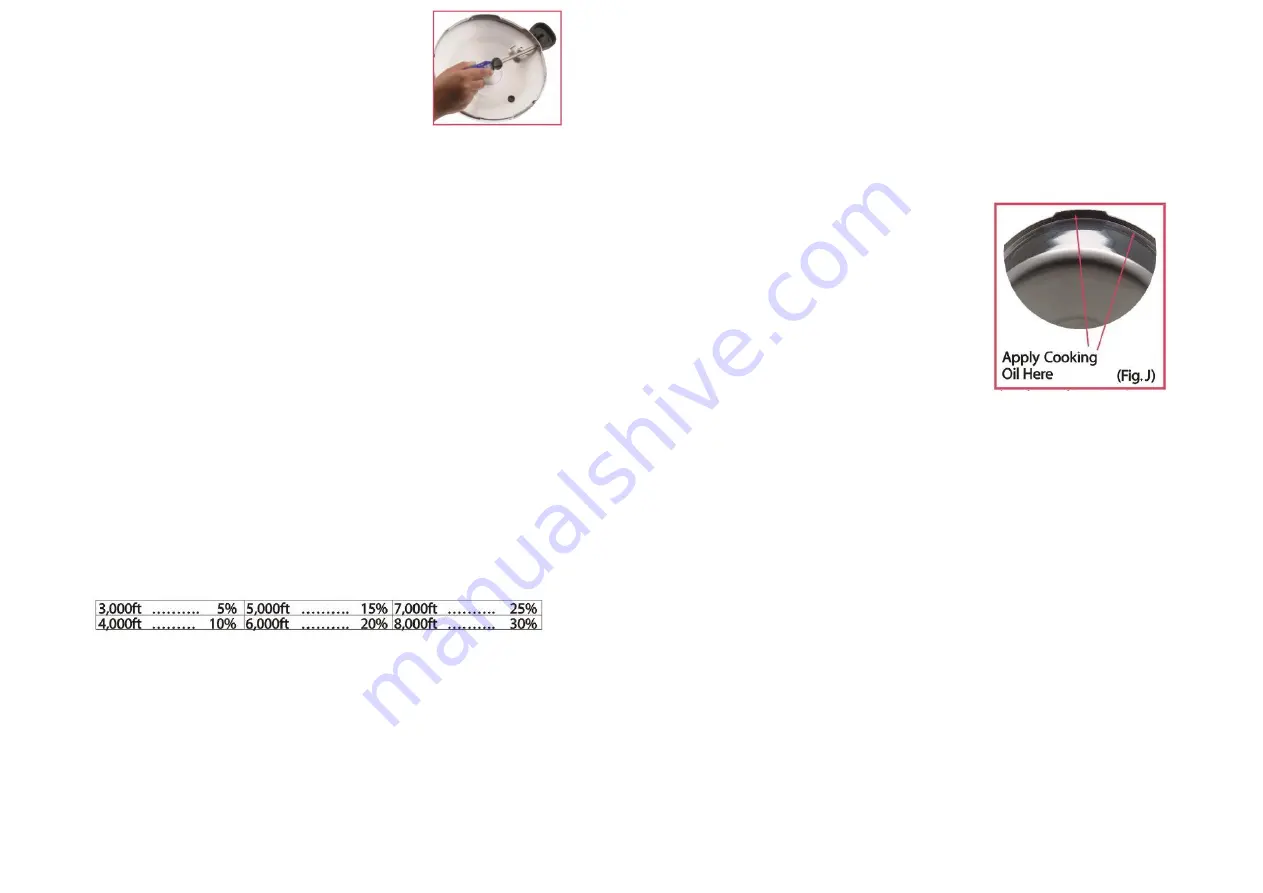
10.
The formation of a small amount of moisture
under the pressure regulator is normal when cooking
first begins; however, it should stop when pressure
begins to build and the overpressure plug and safety lock seals. If leakage continues,
clean or replace the overpressure plug and safety lock assembly. If the pressure
cooker still fails to seal, the gasket from the safety lock may be cracked.
TIPS & HINTS
Your favorite recipes may be adjusted for use in your pressure cooker by following
the cooking chart in this book for the food being prepared. Generally, you can
reduce the cooking time for your recipe by 2/3, since pressure-cooking is much
faster than other cooking methods. For example, if your ordinary cooking method
requires 60 minutes, in the pressure cooker, cooking item will be reduced to 20
minutes. Because there is very little evaporation, the amount of liquid used should
be decreased. Use about 8 oz. more liquid than desired in your finished dish. There
are many different liquids that can be used in a pressure cooker; wine, beer,
bouillon, fruit juices, and water all work excellently. Remember, there must always
be water or some other liquid in the pressure cooker to produce the necessary
amount of steam.
If a pressure cooker recipe or the cooking chart requires a cooking time of 0
minutes, cook the food only until the pressure regulator begins to rock. Remove the
pressure cooker from the heat source and cool according to the recipe. For dilicate
foods such as custards, fresh vegetables, and serving-size pieces of meat,
immediately cool the cooker. For roasts and stew, let the pressure drop of its own
accord.
When cooking at high altitudes, the cooking time needs to be increased 5% for
every 1000 feet above the first 2000 feet. Times should be adjusted as follows:
Because pressure-cooking times are increased at altitudes above 2000 feet,
additional cooking liquid will be needed.
FREQUENTLY ASKED QUESTIONS
The lid is hard to open or close.
The locking lid on your pressure cooker is designed to create an airtight seal. If you
find that the lid becomes difficult to open or close, follow these suggestions:
Hard to close:
Press the palm of you hand on the cover area directly opposite the
cover handle while moving the cover handle to the closed position with your other
hand. After brazing meat or poultry, the cover may be difficult to closed due to
expansion of the pressure cooker body from heating. Allow the presssure cooker
body to cool slightly and try again.
Hard to Open:
Generally, the only reason for the lid to be hard to open is that there
is still pressure built up in the cooker. Allow the cooker to continue to cool until the
lid is easily opened.
Helpful Hint:
To
help make the lid easier to open
and close, a very light application of cooking oil
may be applied to the bottom of the lugs on the
pressure cooker body(Fig.J). Using a pastry brush,
piece of cloth, or your fingertips, apply a small
amount of oil to the lugs, making sure to remove
any excess. Never apply cooking oil to the sealing ring.
There is more liquid in the pressure cooker than
I want.
Reduce over low heat to evaporate the excess liquid.
How do I prevent overcooking?
Accurate timing is essential to preparing a great meal. Always remember to begin
the cooking time when the pressure regulator has begun to gently rock. Using a
kitchen timer will help to ensure that the cooking time is correct. Be sure to follow
the recipe instructions for cooling the pressure cooker, as the food will continue to
cook during the cool down period.
What if the food is not completely done after the recommended cooking time?
Simply bring the cooker back up to pressure and cook the food a minute or two
longer.
How do I know my pressure cooker is operating properly?
The rocking pressure regulator provides both a visual and audible indicator that
your cooker is functioning correctly.
What kind of range is best for pressure-cooking?
Your pressure cooker is very energy-efficient and will work on all stoves and range
tops with the exception of induction ranges
.
When cooking first begins, is it normal for steam to escape and moisture to
form on the cover and between the handles?
Yes. However, if steam continues to vent around the handles and /or cover, the lid
may not be fully locked onto the body.


























